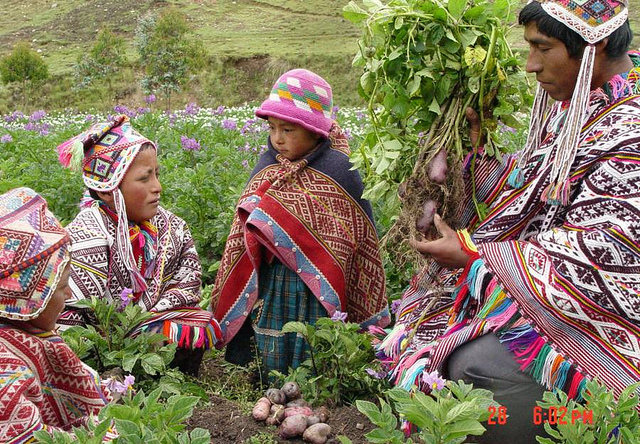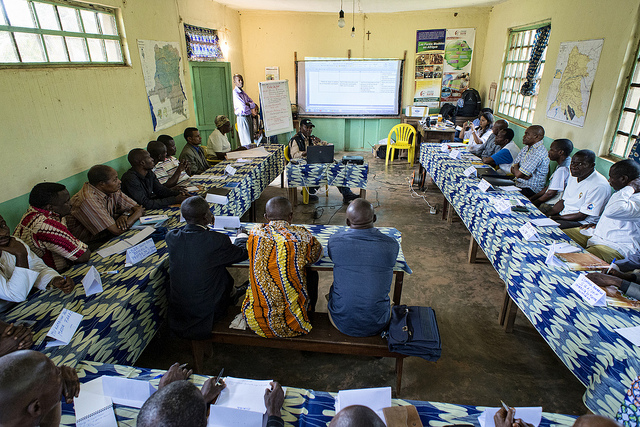How to handle the climate change impacts of a 1.5C warmer world? Key insights from ecosystem- and community-based adaptation practice

Introduction
Climate adaptation planning requires an integrated approach that can address different local needs, priorities and knowledge to build adaptive capacity, while also being contextualised to wider landscapes or ecosystems as well as different geographical scales. Failing to integrate these aspects has resulted in isolated interventions that lose impact or legitimacy over time, or generate negative cascading effects at different scales.
Ecosystem- and community-based adaptation are two approaches that have gained wide attention in the past years but are largely disconnected. This fragmentation can only be addressed through strong collaborative efforts and by bringing different adaptation communities of practice together. It is then when we can meet the challenges we face. Communities are important, but so are ecosystems.
What do we need to do more?
Integrated ecosystem management
The ecosystem approach provides a useful framework for integrated resources management in which human and cultural diversity are at the core. The use of holistic indigenous concepts such as the biocultural heritage concept where the focus is on the interdependencies and relationships between indigenous people and their environment is one example to link EbA with CbA. For example, the Potato Park in Peru is using the indigenous development concept of Sumaq Causay and the 3 ayllus (wild, domesticated/human and sacred) which need to be in balance to achieve wellbeing. This concept emphasizes the interlinkages between traditional knowledge, biogenetic resources, landscapes and ecosystems, cultural and spiritual values and customary laws, and represents a holistic indigenous worldview. This approach emphasizes the link to communities’ values and the importance to embed any technological solution in a socio-cultural context.
Ethnographic research for behavior change
Ethnographic research is crucial to understand why individuals behave in certain ways, why do they have certain values, and how this can be influenced in the future. Adaptation to climate change and variability is a socio-cultural process and may require a change in behavior and a change in our value system, which is embedded in the socio-cultural context we live in; hence the importance of ethnography in adaptation research.
Building climate resilience with an initial vulnerability assessment
Climate change is only one of the multiple stressors that could exacerbate many of the existing vulnerabilities in a given area, and adds complexity to many of the existing inequalities. Understanding the local context, community needs and the interplay with the ecosystems people manage is the foundation for any adaptation process. This should build on local traditional knowledge and be supported by scientific knowledge. The challenge remains how to manage the integration of climate resilience in other projects (e.g. health) that are not necessarily designed from a climate perspective, and its integration into planning. Conducting a vulnerability and capacity assessment is an important starting point of any development project or programme that needs to consider climate change action at the same time. This would allow us to understand whether climate change is particularly important in a given context, who and what the vulnerable groups and sectors in a specific area are, and how and/or whether both ecosystems and communities have learned or developed strong resilience to variations to climate change and variability.
Multidisciplinary teams and co-creation of knowledge
The establishment of multidisciplinary teams helps deal with fragmentation of information and sectoral approaches, and it is essential to be able to seek integrated responses to adaptation to climate change. More importantly, the role of a knowledge broker or intermediary can help bridge different disciplines and types of knowledge. Information needs to be good enough to be used and to be able to inform decision-making processes. Facilitating the exchange of knowledge and improving the access and use of both scientific and traditional knowledge, and translating or packaging it for different audiences needs to be a priority.
Work at the interface of science-policy-practice through processes of co-creation of knowledge enables linking different knowledges and people from a variety of backgrounds. It helps develop a shared understanding of adaptation problems, and manage expectations and diverging interests. It also helps raise environmental awareness among all the institutions involved in the process in order to seek holistic adaptation solutions, which in turn help develop alliances between individuals, organizations and agents of change around common issues and shared interests. The co-creation of knowledge provides a space for building relationships based on mutual understanding, social learning, innovation and for social validation of adaptation actions. For example, in EcoAdapt, Model Forests are used as platforms to build partnerships between scientists, the civil society and other groups of individuals and institutions that operate in each context to co-produce knowledge around ecosystem services and water governance. This means that researchers have worked and co-lead the project together with Civil Society Organisations (CSOs) embedded in the realities of their local contexts, mainly with Model Forests in the Latin America region (Bolivia, Chile and Argentina).
By strengthening current participatory spaces and/or using current institutions such as existing platforms (e.g. model forests, etc.) or schools involving different groups of people to establish dialogue and collaboration, there are more chances to achieve wider impact at scale but also these institutional processes can be easily sustained over time as they build from existing ones.

Adaptive management
A collaborative process in adaptive management in which multiple stakeholders participate in learning and develop a shared understanding around the problems and issues at hand, establishing goals, objectives and robust management decisions will be essential to achieve success. This entails an iterative process in the face of uncertainty and involves highly participatory and flexible bottom-up processes so that decisions are being made as new knowledge and credible science, with the experience and values of stakeholders and managers, is being used or becomes available.
These bottom-up participatory processes need to use flexible methods and tools for fieldwork, for planning purposes, in policy, and that are inclusive of all stakeholders including local communities (e.g. land use plans that include tools for restoration so that local communities are involved in and get incentives for restoring their own land). They also need to take into account several aspects such as local adaptation needs; both traditional and scientific knowledge; the feasibility of implementation of adaptation actions; as well as favorable conditions, the urgency, the capacity needed, the enabling factors or existing processes/initiatives; and expected impact of the action.
Capacity building
The development of new capacities in different Ministries is very much needed, especially in developing country contexts. In this regard, capacity building in the context of climate change (i.e. including basics of climate science) and the linkages between disaster risk reduction, sustainable development, adaptation and mitigation to climate change is key. In addition, communication and negotiation skills as well as collaborative work in institutional culture are key, and very much needed in order for ministries and departments to interact and influence each other rather than working in silos, which is what often is found. Communication skills are indispensable and very much needed in transdisciplinary research where viewpoints and perceptions can vary widely. Distilling key messages from the work that is being done is of particular importance for multi-stakeholder engagement and these will have to reach different audiences, from politicians to NGOs, to the private sector and beyond.
Reciprocal watershed agreements
The use of in-kind incentives seems a promising mechanism to protect environmental services. This kind of incentive is being promoted by Fundación Natura in Bolivia (read more here). As opposed to the Payment for Ecosystem Services (PES), this approach avoids actual payment for ecosystem services, as paying for something that has been free for thier whole life does not make sense for poor people. It is a basic reciprocity model that requires a few institutions to participate, such as the water cooperative, water users, local NGOs and the municipal government, to put some funding into protecting water supplies. For each municipal government this means to invest a total of 4,000-6,000 USD a year, but 80% of the costs come from water users and local governments, so they are already 80% self-funded before an NGO comes in. For water users, what this means is that they pay a little extra in their water bills.
|
Today in Bolivia, there are 31 municipal water funds, financed by 226,435 downstream water users, supporting 3,147 upstream families with bee boxes, fruit tree seedlings, plastic pipes, etc. in exchange for the conservation of 178,448 ha of biodiverse forest, which is returning 500,000 m3 of water to the aquifer and storing 290,000 tons of carbon.
This piece of content is based on insights shared at a COP21 side-event on integrating ecosystem- and community-based adaptation co-hosted by SEI and CIRAD, and aims to shed light to a few lessons learnt over the years from researchers and practitioners based on on-the-ground adaptation practice that can inform the future adaptation practice in a 1.5C warmer world.
The main contributers to the side event at COP21 were:
Angela Andrade (Conservation International/IUCN)
Keith Alverson (UNEP)
Nigel Asquith (Fundación Natura Bolivia)
Alejandro Argumedo (Andes)
Krystyna Swiderska (IIED)
Monica Coll Besa (SEI)
Related resources
- The EcoAdapt Project
- Integrating ecosystem- and community-based adaptation: Lessons from Model Forests in Latin America
- Introducing Biocultural Heritage Territories
- The importance of working at the science-society interface for adaptation to climate change
- Using traditional knowledge for adaptation, disaster risk reduction and natural resource management in Nicaragua
- Adaptation and resilience in Vanuatu: Interpreting community perceptions of vulnerability, knowledge and power for CBA
- Climate Vulnerability and Capacity Analysis (CVCA)
- Climate Vulnerability and Capacity Analysis in central Tanzania
- Building coastal resilience to reduce climate change impact in Baan Tha Klong, Thailand
- ‘Watershared’ – Adaptation, mitigation, watershed protection and economic development in Latin America
(0) Comments
There is no content